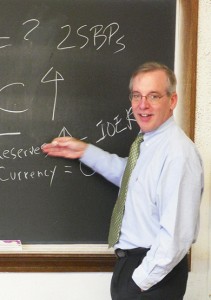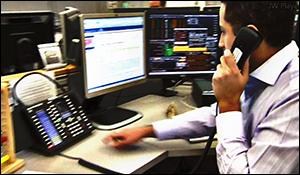By Pam Martens: December 30, 2013
The Federal Reserve System that is charged with setting monetary policy in the United States consists of a Board of Governors in Washington, D.C. and 12 regional Federal Reserve Banks. The Board of Governors functions as an independent government agency – its Board is appointed by the President of the United States but its funding comes from the regional Federal Reserve Banks.
Slowly, like a tiny Goldfish in a large tank of water that grows over time into a monster fish capable of clobbering anything else placed in the tank, one of the 12 regional Federal Reserve Banks has obtained unique powers not shared by the 11 other regional Federal Reserve Banks.
This is just a partial list of how the New York Fed is unique among its peers:
The President of the New York Fed sits permanently on the Federal Open Market Committee (FOMC). The Presidents of the other 11 regional banks rotate on the FOMC;
Although there is no law requiring that the New York Fed should be the sole regional Fed Bank to conduct the open market operations of the FOMC, it has uniquely served in this function since 1935;
It is the only regional Fed Bank to have its own trading floor and speed dials to the largest firms on Wall Street;
It is the only regional Fed Bank to be allowed to intervene in foreign exchange markets;
The New York Fed, uniquely among the regional Fed Banks, stores gold for foreign central banks, governments and international agencies;
The New York Fed played a uniquely controlling role in the disbursement of trillions of dollars in loans to foreign and domestic banks during the 2007 to 2010 meltdown of Wall Street;
And, problematically, while needing the good will of Wall Street firms to carry out its open market operations mandate, it simultaneously functions as a primary regulator to some of the largest firms.
Over the past several years, Wall Street On Parade has identified for its readers a raft of conflicts of interests at the New York Fed that would not be tolerated at any other financial regulator. For example, its Board of Directors has routinely included the CEOs of the very same Wall Street firms it regulates.
Sandy Weill, the former Chairman and CEO of Citigroup, served two terms on its Board, from 2000 to 2006, as Citigroup built up a toxic time bomb of Structured Investment Vehicles (off balance sheet debt) and subprime mortgage exposure that would, from 2008 to 2010, require a taxpayer bailout totaling $45 billion in equity, over $300 billion in asset guarantees, and more than $2 trillion in low cost loans from (wait for it) – its own regulator, the New York Fed.
Presiding over the New York Fed as this toxic brew fermented at Citigroup was Timothy Geithner, President of the New York Fed from 2003 through the crash of 2008. Geithner became U.S. Treasury Secretary following his five years at the New York Fed. Multiple insiders have written books about what they perceived to be Geithner’s favoritism to Citigroup as Treasury Secretary.
In Confidence Men, Ron Suskind says that Geithner ignored a directive from President Obama to wind down Citigroup. Sheila Bair, former head of the FDIC during the crisis, portrays Geithner in Bull By the Horns as little more than Citigroup’s messenger boy.
The public should rightfully expect that a regulator that presided over the greatest Wall Street collapse since the Great Depression would have its wings clipped by Congress. Instead, the New York Fed has actually found ways to become more hubristic.
In early 2012, as JPMorgan was building up an unmanageable position in illiquid, toxic derivatives in a dark corner of its trading empire in London using the insured deposits of its banking customers, its Chairman and CEO, Jamie Dimon, was sitting on the Board of Directors of the New York Fed. As it was being investigated by the New York Fed, Jamie Dimon continued to sit on its Board, serving out his two terms which ended at the end of 2012. This debacle became infamously known as the London Whale trades. JPMorgan has owned up to $6.2 billion in losses from those derivatives.
In March, Senator Carl Levin told the Senate’s Permanent Subcommittee on Investigations that JPMorgan, in carrying out the London Whale trades, “piled on risk, hid losses, disregarded risk limits, manipulated risk models, dodged oversight, and misinformed the public.” Does that sound like a Wall Street firm that’s afraid of its regulators?
While all of this was happening at JPMorgan, Bill Dudley was serving as the President of the New York Fed and his wife, Ann Darby, a former Vice President at JPMorgan, was receiving approximately $190,000 per year in deferred compensation from JPMorgan – an amount she is slated to receive until 2021 according to financial disclosure forms.
According to the New York Fed’s web site, its “employees are subject to the same conflict of interest statute that applies to federal government employees (18 U.S.C. Section 208).” Under that statute, a spouse’s conflicts become the conflicts of the employee.
Last month, I asked the New York Fed in an email if it had changed its position on allowing this compensation to continue to flow to the household of its President. I was informed that “after further discussions and analysis by the New York Fed’s lawyers, it was agreed that Ms. Darby’s fixed deferred compensation from her previous employer neither posed a conflict nor required a waiver.”
Now, thanks to Carmen Segarra, a lawyer and former Bank Examiner at the New York Fed, we are learning about the cozy role of Relationship Managers at the New York Fed. In October, Segarra filed a lawsuit alleging that Relationship Managers at the New York Fed, who were assigned to manage the “relationship” with Goldman Sachs, obstructed and interfered with her investigation of the firm and tried to bully her into changing her findings. When Segarra refused to change her findings, she was fired, according to the lawsuit.
In July of last year, Wall Street On Parade reported on how a Barclays’ employee told a Senior Financial Economist at the New York Fed that his bank was not “posting um, an honest LIBOR.” That conversation, denoting one of the biggest cartel frauds in history, occurred in April 2008, and yet, no one at the New York Fed thought it necessary to alert the U.S. Justice Department that one of the benchmark interest rates used to index financial products around the world was being intentionally rigged.
It is abundantly clear to anyone who takes the time to study the New York Fed’s business model that it is part of the Wall Street problem and cannot, under this structure, be part of the solution. The question is, how long will it take Congress to remove its blinders to this dangerous concoction of a regulator.



